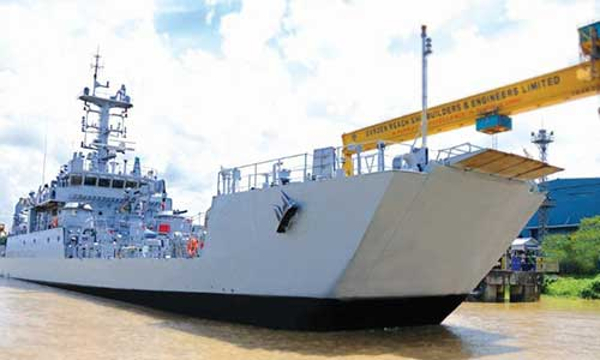The anticipated delivery time lines for the first vessel is maximum of 60 months followed by delivery of one vessel every 12 months (from the date of contract award).
According to the RFI, a Request for Proposal (RFP) will be issued to the shipyards who have completed the feasability examination and fullfilled all requirements needed.
Here is what the RFI call for in terms of operational requirements: “
The Landing Platform Dock (LPDs) shall be capable to transport and land ashore a combined arms force and to sustain their operations ashore. Inherent to this capability would be a capacity to embark and sustain a body of troops at sea for prolonged durations, to embark, stow onboard and discharge at the objective the full range of the combat cargo required for undertaking and sustaining the operations ashore and to enable operation of multiple means of ship to shore movement of troops and cargo. LPDs will undertake Out of Area Contingencies (OOAC) through its inherent capability to transport and deploy forces ashore, ability to arrive quickly in area, and sustain operations at sea for prolonged durations. LPDs will act as Command Centre for the Commander, Amphibious Task Force, Landing Force Commander and the Air Force Commander and also undertake Humanitarian Assistance and Disaster Relief Missions. Additionally, LPDs will also act as mother ship for unmanned capability and to support operation/ exploitation of all dimensions of futuristic unmanned vehicles/ platforms/ equipment. The LPDs will also provide medical facilities for treatment of battle casualties.”
Technical specifications:
Regarding the specifications, the LPDs will feature a crew of 540 sailors with a capacity to embark 900 troops. Ships should be up to 200 meters-long, have a draft up to 8 meters full loaded and achieve a cruising speed of 14 to 16 knots. The range should reach 10,000 nautical miles at economical speed. The ships are to be provided with an Electric Propulsion (Integrated Full Electric Propulsion/ Hybrid Propulsion) System.
In terms of weapons, the LPDs should be equipped with 32 Vertical Launch – Short Range Surface to Air Missile (VLSRSAM) and 16 anti-ship missiles. In terms of guns, the RFI calls for the capacity to embark 4 x AK 630 CIWS with electro optical fire control system, 6 HMGs with stabilized gun control stations/ SRCGs, directed energy weapon (in lieu of AK 630 when developed) and 8 MMGs.
The sensor suite will consist in one E/ F Band combined air and surface surveillance radar, one 3D C/D Band air surveillance radar, one surface surveillance radar, two ‘I’ Band, one E/F COTS radars and one EO/IRST.
The ship should have a ‘through deck’ (therefore an LHD – Landing Helicopter Dock, rather than an LPD – Landing Platform Dock) design and be capable of accommodating at least two heavy lift helicopters, 12 Special Operations Helicopters and 2 NSUAS (Naval Ship-born Unmanned Aerial System) and permit simultaneous operations of at least 04 Special Ops helicopters (includes operation of 1 NSUAS in lieu). Out of these, at least 12 Special Operations Helicopters and 2 NSUAS would be stowed inside the hangar and atleast 02 Heavy Lift Helicopters would be parked on the deck in blade folded configuration. The foremost helicopter spot is to be strengthened to operate a Heavy Lift Helicopter, with max All Up Weight of 40 Tons.
For stowage of the helicopters in below deck hangarage, the LPD is to be fitted with two aircraft lifts, one main and one standby lift. The main lift should serve the hangar as well as the vehicle deck(s). Both should have a 24 tonnes bearing capability.
As for its amphibious capacity, each ship should be able to accommodate 4 LCVPs (Landing Craft Vehicle Personnel) and 4 LCMs (Landing Craft Mechanized ). Later, the ships are to be fitted to embark two LCACs each in lieu of 4 LCMs.
You may also like
-
IAF Aircraft Set Course For Exercise Eastern Bridge VII At Oman
-
IAF Set To Host The Indian Defence Aviation Exposition-II At Jodhpur
-
Defence Secretary to co-chair 5th India-Philippines Joint Defence Cooperation Committee meeting in Manila
-
Simultaneous Launch Of ‘malpe And Mulki’, Fourth And Fifth Ships Of Asw Swc (Csl) Project
-
Aatmanirbharta in Defence: MoD signs Contract with HAL for 240 AL-31FP Aero Engines for Su-30MKI Aircraft
